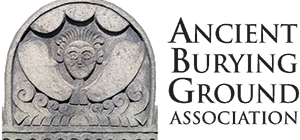Around the turn of the nineteenth century, angel’s heads were rapidly displaced on gravestones by imagery that included classical symbols of mourning such as urns and weeping willows. These more secular illustrations reflected several developments, including the loosening of the grip of Puritan religious orthodoxy on Connecticut and the young United States’ increasing identification with the noble qualities of ancient Greece and Rome.
Roderick Olcott, 1801
“Sacred to the Memory of Mr. Roderick Olcott who departed this life August the 3d AD 1801 in the 36th year of his age”
The urn and willow motif featured on Roderick Olcott’s gravestone was introduced into the lower Connecticut River Valley by Middletown stonecutters around 1790.
The Maker of the Markers: A Walking Tour of Colonial Stonecutter Art Brochure (below) identifies several of the carvers whose work can be seen at the Ancient Burying Ground.
